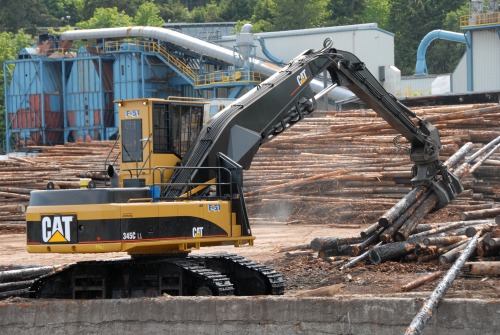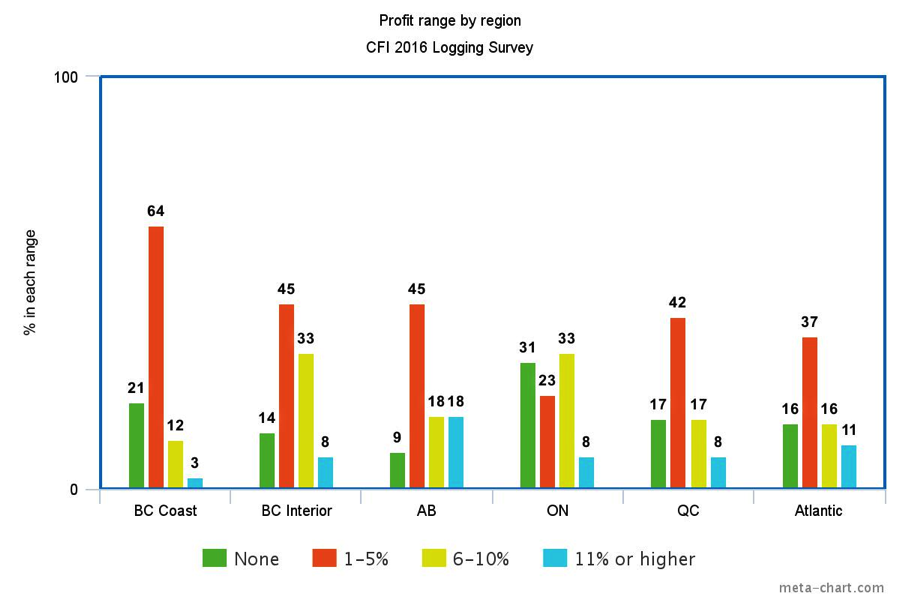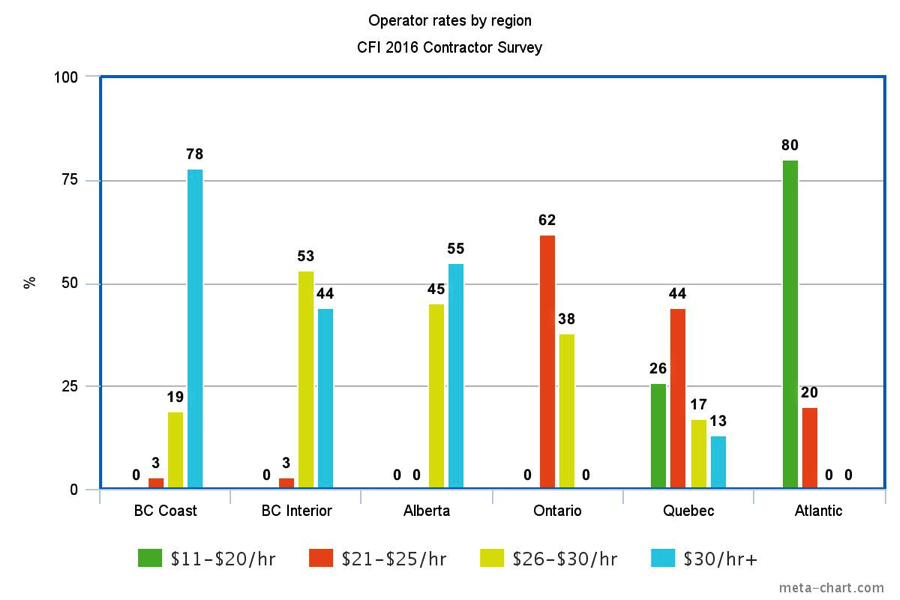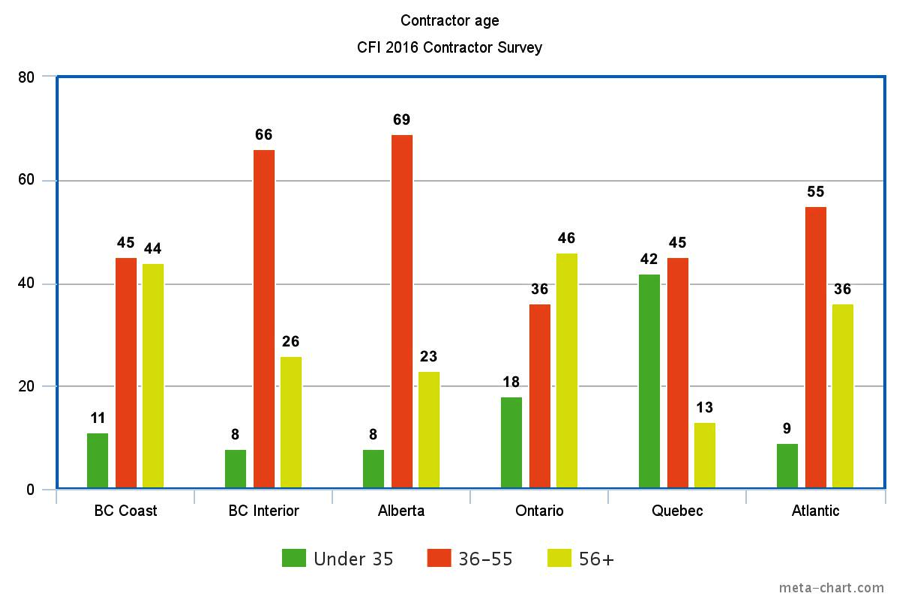
Features
Harvesting
Logging Profiles
A breakdown in relations?
Oct. 18, 2016 - More than anywhere else in Canada, contractors on the BC Coast are concerned about a recent souring of relations with the industry they supply. That, and stagnant rates and declining profitability are reasons why succession planning may be a bigger challenge here.
October 18, 2016 By Scott Jamieson

Job satisfaction is a relative concept, and the loggers on the BC Coast are relatively unsatisfied with their recent lot in life. Based on results from the 2016 Canadian Forest Industries Contractor Survey, logging contractors across Canada continue to struggle with stagnant logging rates, climbing machine costs, and staffing challenges. Yet those on the Coast feel they have seen their margins and mill relationships increasingly strained in recent years, perspectives that have them questioning logging as a career for themselves and their families. In general, Coastal contractors reported the following:
Rates & profits
Across Canada, only 41 per cent of contractors saw a rate increase in the past three years. While not great, that’s still marginally better than the BC Coast, where just 39 per cent of contractors say they’ve seen a rate increase in the past three years – take note, that’s over the past three years, not just last year. Nor does a basic rate increase guarantee keeping up with rising costs of machinery, parts and much else.
That compares harshly to the BC Interior, where 63 per cent of loggers have seen a rate increase in the past three years. Only loggers in Quebec, Atlantic Canada and Ontario have fared worse, regions where the industry has been much slower to return to profitability in the current slow recovery. Stagnant rates appear to be a central reason why Coastal loggers so often mention a worsening of relations between them and the license holders.
As for profits, BC Coastal loggers fare poorly compared to the rest of Canada. More than one in five (21%) claim to have made no profit last year, compared to 17 per cent across Canada. Only Ontario loggers fared worse, with 31 per cent of loggers there reporting no profit in 2015. Even loggers in hard hit Quebec and Atlantic Canada have fared better in recent years, with a noticeably better profit profile (see chart). To be sure, loggers there are making that percentage of profit on smaller revenues.
The BC Coast sits in the middle of the pack for trends in logger profitability, where 44 per cent of loggers say profits were lower last year than three years ago (Canadian average was 41 per cent). Given the general industry recovery over that period, the fact that only 15 per cent of Coastal loggers and 16 per cent of all Canadian loggers say their profits have increased is a concern.
Operator pay
Operator hourly rates vary greatly by region, with competition in places like BC and Alberta driving rates higher than elsewhere on average. Loggers on the BC Coast pay the highest operator rates in Canada, even higher than those in Alberta. So while only 37 per cent of Canadian loggers pay wages above $30/hr, over three quarters (76%) of Coastal loggers do. That compares to 44 per cent in the BC Interior and 55 per cent in Alberta, perhaps a reflection of the unique skill sets required for Coastal logging. 
Employee benefits show similar patterns, with 85 per cent claiming to pay some operator benefits versus 71 per cent in Canada as a whole. Only the BC Interior has a higher percentage of contractors offering employee benefits at 94 per cent. Overall, Coastal contractors are supplying the region with good paying jobs, and for the most part are able to do so for most of the year, as their operations are active for more of the year than elsewhere.
Workload
Loggers across Canada work long hours as a rule, but when it comes to weekly hours Coastal contractors tend to work fewer hours than their counterparts elsewhere. While 61 per cent of Canadian loggers work more than 55 hrs/week, 56 per cent of Coastal loggers do so. That compares to 75 per cent in the Interior and 73 per cent in Alberta.
The rub is that Coastal operations also tend to run far more weeks per year than anywhere else in Canada. Almost two-thirds (62%) run 41 to 52 weeks per year, with only Atlantic Canada coming close to that pace (58%).
The life/work balance may be better on the Coast than their counterparts in the Interior or Alberta (at least while they run), but it is still nothing to brag about when trying to attract the next generation of loggers. Seventy-seven per cent of contractors on the Coast are working over 46 hours per week for the better part of the year. Only Quebec seems to have the life/work balance heading in the right direction, but even there it seems out of whack with most of the general economy.
Company size
Regardless of how you measure it, BC Coastal contractors skew to the large side compared to the Canadian average. Given piece size, boasting higher volumes is a no brainer for all BC contractors – they skew much larger than their counterparts further east. This is the case with staffing as well, with 61 per cent of coastal loggers having 21 or more employees, higher than the national average of 46 per cent, but trending smaller than colleagues in the Interior, where 67 per cent have 21 or more employees.
In terms of machinery, 61 per cent of Coastal loggers have 11 or more machines, again higher than the national average (51%) but smaller than both the Interior (78%) and Alberta (72%), regions essentially 100 per cent mechanized.
BC Coastal loggers also tend to drive higher revenues than counterparts across Canada, with 47 per cent having earnings over $5 million, versus 38 on average across Canada. That Canadian average falls further still if the BC Interior is excluded, as 69 per cent there have revenues over $5 million.
Mill consolidation
Many loggers are faced with fewer and fewer sawmills to sell their products and services to, a general concern that affects some regions more than others. While the majority of Coastal loggers report having four or more mills in their region, the reality of how many they actually sell to is different.
Over half (56%) note that they sell to only one or two mills in practice, while almost 20 per cent say they can only sell product to a single mill. This was repeatedly mentioned as a source of conflict among both coastal and Interior mills.
Contractor age
Given the company size and equipment investment, it is not surprising that contractors on the BC Coast also skew older than the Canadian average. Two thirds (67%) of Coastal loggers are 46 years or older. That compares to 56 per cent across Canada, signs of a national workforce in general in bad need of renewal. Only 11 per cent of Coastal contractors are under 35, which compares well with the Interior (8%), Alberta (8%), and Eastern Canada (9%). In comparison Ontario (19%) and Quebec especially (42%) skew much younger.
In fact, only 13 per cent of Quebec respondents placed themselves as 56 years of age or older. Compare that to 46 per cent in Ontario, 44 per cent on the BC Coast, and 36 per cent in Atlantic Canada, all regions that need to treat succession planning with urgency. 
The next generation
That urgency is all the more apparent when the retirement and succession planning of Coastal loggers are considered. A whopping 50 per cent say it is very unlikely they will still be working as loggers in five years time, and that they are actively looking at alternatives. Only Ontario has a number even close to this high looking at leaving the industry inside five years (40%), while nationally only 10 per cent of loggers expect to leave the industry within five years.
Opinion on this on the Coast seems to be split down the middle though, with 50 per cent saying it’s very likely they’ll still be in the industry in five years, as they like the work. It would be interesting to see if this relates to the companies they log for, but for reasons of anonymity CFI did not collect data on this.
Also interesting is that 50 per cent of Coastal loggers say the logging sector has greatly deteriorated as a place to earn a living versus 10 years ago, with the other 50 per cent saying it’s a touch better. That compares to the Interior where 75 per cent say it is much worse or slightly worse than 10 years ago. Overall, we see a BC logging force that perceives its working life in decline.
Despite their age, only 39 per cent of Coastal loggers have a succession plan that involves children or employees. Also, 45 per cent say they have no interest in children taking over, compared to 30 per cent across Canada as a whole and 40 per cent in the Interior. In both BC regions the sentiment that logging is not a fit career for their children is at least twice as prevalent as it is in other regions.
This sentiment was echoed in the comments section of the survey, where contractors across the Coast echoed this long-time logger’s thoughts on mill-logger relations.
“The adversarial relationship between contractors and licensees is a major distraction for both parties. It is preventing both from collectively working on improving efficiencies in the supply chain. Failure to change this will continue the trend of the coastal forest industry becoming increasingly uncompetitive in the global market.”
The survey shows a clear challenge ahead for the industry along the BC Coast.
The Canadian Forest Industries 2016 Contractor Survey was conducted in April 2016 for Canadian Forest Industries and Operations forestieres et de scierie by independent research firm Bramm & Associates, generating over 230 replies to a detailed list of questions. Many thanks to our sponsors for making this vital research possible – Hultdins, Stihl, Tigercat and Ponsse. Read all 15 of the survey snippets.
Print this page